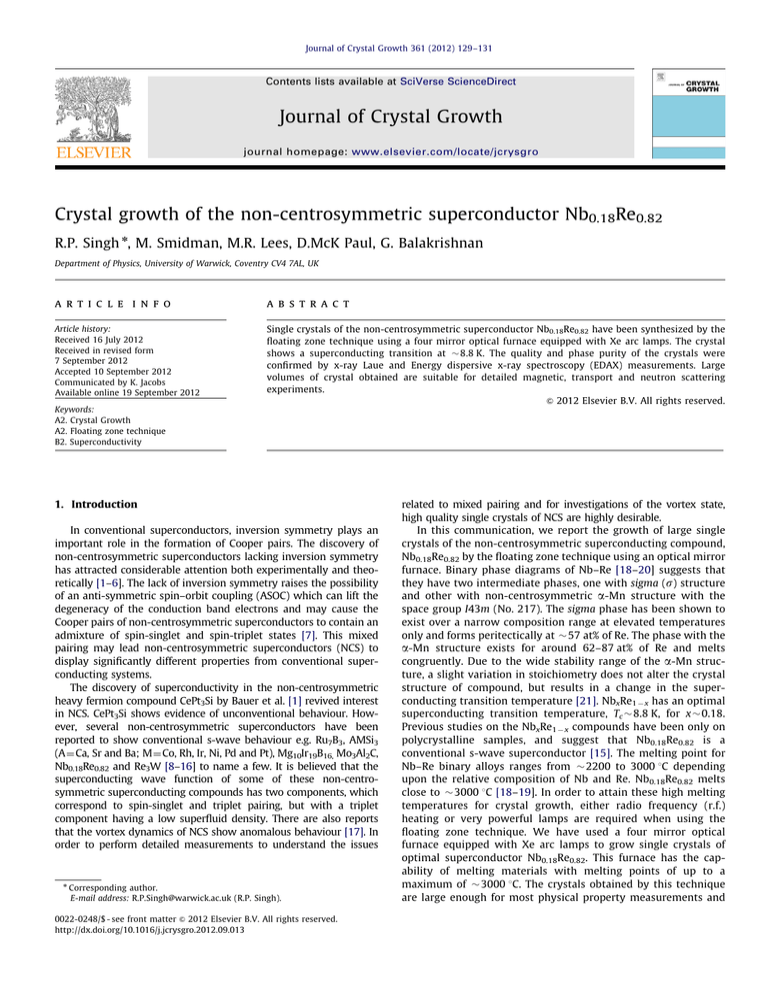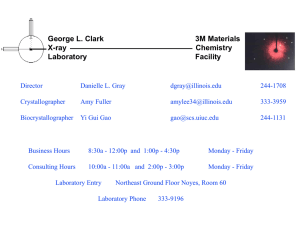
Journal of Crystal Growth 361 (2012) 129–131
Contents lists available at SciVerse ScienceDirect
Journal of Crystal Growth
journal homepage: www.elsevier.com/locate/jcrysgro
Crystal growth of the non-centrosymmetric superconductor Nb0.18Re0.82
R.P. Singh n, M. Smidman, M.R. Lees, D.McK Paul, G. Balakrishnan
Department of Physics, University of Warwick, Coventry CV4 7AL, UK
a r t i c l e i n f o
abstract
Article history:
Received 16 July 2012
Received in revised form
7 September 2012
Accepted 10 September 2012
Communicated by K. Jacobs
Available online 19 September 2012
Single crystals of the non-centrosymmetric superconductor Nb0.18Re0.82 have been synthesized by the
floating zone technique using a four mirror optical furnace equipped with Xe arc lamps. The crystal
shows a superconducting transition at 8.8 K. The quality and phase purity of the crystals were
confirmed by x-ray Laue and Energy dispersive x-ray spectroscopy (EDAX) measurements. Large
volumes of crystal obtained are suitable for detailed magnetic, transport and neutron scattering
experiments.
& 2012 Elsevier B.V. All rights reserved.
Keywords:
A2. Crystal Growth
A2. Floating zone technique
B2. Superconductivity
1. Introduction
In conventional superconductors, inversion symmetry plays an
important role in the formation of Cooper pairs. The discovery of
non-centrosymmetric superconductors lacking inversion symmetry
has attracted considerable attention both experimentally and theoretically [1–6]. The lack of inversion symmetry raises the possibility
of an anti-symmetric spin–orbit coupling (ASOC) which can lift the
degeneracy of the conduction band electrons and may cause the
Cooper pairs of non-centrosymmetric superconductors to contain an
admixture of spin-singlet and spin-triplet states [7]. This mixed
pairing may lead non-centrosymmetric superconductors (NCS) to
display significantly different properties from conventional superconducting systems.
The discovery of superconductivity in the non-centrosymmetric
heavy fermion compound CePt3Si by Bauer et al. [1] revived interest
in NCS. CePt3Si shows evidence of unconventional behaviour. However, several non-centrosymmetric superconductors have been
reported to show conventional s-wave behaviour e.g. Ru7B3, AMSi3
(A¼Ca, Sr and Ba; M¼Co, Rh, Ir, Ni, Pd and Pt), Mg10Ir19B16, Mo3Al2C,
Nb0.18Re0.82 and Re3W [8–16] to name a few. It is believed that the
superconducting wave function of some of these non-centrosymmetric superconducting compounds has two components, which
correspond to spin-singlet and triplet pairing, but with a triplet
component having a low superfluid density. There are also reports
that the vortex dynamics of NCS show anomalous behaviour [17]. In
order to perform detailed measurements to understand the issues
n
Corresponding author.
E-mail address: R.P.Singh@warwick.ac.uk (R.P. Singh).
0022-0248/$ - see front matter & 2012 Elsevier B.V. All rights reserved.
http://dx.doi.org/10.1016/j.jcrysgro.2012.09.013
related to mixed pairing and for investigations of the vortex state,
high quality single crystals of NCS are highly desirable.
In this communication, we report the growth of large single
crystals of the non-centrosymmetric superconducting compound,
Nb0.18Re0.82 by the floating zone technique using an optical mirror
furnace. Binary phase diagrams of Nb–Re [18–20] suggests that
they have two intermediate phases, one with sigma (s) structure
and other with non-centrosymmetric a-Mn structure with the
space group I43m (No. 217). The sigma phase has been shown to
exist over a narrow composition range at elevated temperatures
only and forms peritectically at 57 at% of Re. The phase with the
a-Mn structure exists for around 62–87 at% of Re and melts
congruently. Due to the wide stability range of the a-Mn structure, a slight variation in stoichiometry does not alter the crystal
structure of compound, but results in a change in the superconducting transition temperature [21]. NbxRe1 x has an optimal
superconducting transition temperature, Tc 8.8 K, for x 0.18.
Previous studies on the NbxRe1 x compounds have been only on
polycrystalline samples, and suggest that Nb0.18Re0.82 is a
conventional s-wave superconductor [15]. The melting point for
Nb–Re binary alloys ranges from 2200 to 3000 1C depending
upon the relative composition of Nb and Re. Nb0.18Re0.82 melts
close to 3000 1C [18–19]. In order to attain these high melting
temperatures for crystal growth, either radio frequency (r.f.)
heating or very powerful lamps are required when using the
floating zone technique. We have used a four mirror optical
furnace equipped with Xe arc lamps to grow single crystals of
optimal superconductor Nb0.18Re0.82. This furnace has the capability of melting materials with melting points of up to a
maximum of 3000 1C. The crystals obtained by this technique
are large enough for most physical property measurements and
130
R.P. Singh et al. / Journal of Crystal Growth 361 (2012) 129–131
ideal for neutron scattering experiments, where large volumes of
single crystals are essential.
2. Experimental
Polycrystalline samples were prepared by arc melting in a tetraarc furnace (Cyberstar, Grenoble, France) on a water cooled copper
hearth. The starting materials, high purity (5N) Nb and Re ingots,
were melted under an argon gas (5N) atmosphere. The buttons were
melted and flipped several times to ensure phase homogeneity. The
observed weight loss during the melting was negligible. The phase
purity of the polycrystalline buttons was checked by powder x-ray
diffraction. Several polycrystalline buttons obtained in this manner
were then melt cast in the shape of a rod ( 40 mm in length and
3 mm in diameter) in a tri-arc furnace under an argon atmosphere. These rods were used as feed rods for the crystal growth in a
high temperature optical furnace equipped with four 3 kW Xe arc
lamps (CSI Model FZT-1200-X-VI VP). A tungsten rod of the same
diameter was used as the seed rod for the first crystal growth and
the crystal obtained was used as the seed for subsequent growths.
The growth chamber was evacuated to a vacuum of 10 6 mbar
(10 4 Pa) prior to starting the growth and then filled with argon gas
to a pressure of 0.3 MPa for the growth. The crystal growth was
carried out under a flow (1.0 l/min) of high purity argon gas. The
feed and seed rods were rotated at 25–30 rpm and crystal growths
were carried out at speeds of 3–6 mm/h. The crystals obtained were
typically 30–35 mm long and 3 mm in diameter.
3. Results and discussion:
Fig. 1 shows an as-grown boule of Nb0.18Re0.82. The boule is shiny
with a metallic lustre. Nb0.18Re0.82 melts congruently and therefore
lends itself to crystal growth by the floating zone method. The molten
zone was stable throughout and the best crystals were obtained for
slow growth rates 3 mm/h. The crystals could be cut using a low
speed diamond saw and did not require the use of a spark cutter.
Prior to cutting, the crystals were examined using x-ray Laue back
reflection. X-ray Laue photographs were collected along the length of
each crystal at 1.5 mm intervals on several faces to confirm the
crystal quality. The lower panel of Fig. 1 shows the x-ray Laue
patterns obtained at three different positions along the length of the
crystal grown at 3 mm/h. The photographs show sharp consistent
patterns for the whole sample, confirming the high quality of single
crystal. By use of the x-ray Laue patterns, crystals oriented along
particular crystallographic axes were cut from the as-grown crystal
for measurements. X-ray powder diffraction pattern taken on a small
portion of powdered single crystal suggests that the compound is
single phase and lattice parameters agree well with those reported for
the polycrystalline Nb0.18Re0.82 [15]. Composition analysis was carried
Fig. 2. Variation of magnetic susceptibility with temperature in an applied field
along the [100] axis.
out by EDAX measurements using a SEM (JEOL 6100) to confirm
the stoichiometry of the single crystal. The results obtained
confirm that the average stoichiometry of the boule (Re¼8472
and Nb¼1672 at%) is very close to that of the feed rod
(Re¼81.972.9 and Nb¼18.1 72.9 at%) used for the crystal
growth. In order to check the superconducting properties of the
crystal, dc magnetic susceptibility measurements were made
using a Quantum Design Magnetic Properties Measurement
System. Fig. 2 shows the magnetic susceptibility as a function of
temperature for a field applied along the [100] axis of the crystal.
The observed superconducting transition temperature, Tc 8.8 K
(Tc onset), in our single crystals is higher than that previously
reported for polycrystalline ingots of the same composition
measured by dc susceptibility (Tc onset 8.0 K) [15]. Detailed
magnetization, transport and heat capacity measurements on the
single crystals are currently in progress. Muon spin rotation and
small angle neutron scattering studies are planned on the crystals
to investigate the coupling mechanism and vortex state respectively in this superconductor.
In conclusion, we have been able to grow high quality single
crystals of Nb0.18Re0.82 by the floating zone method using a four
mirror optical furnace equipped with Xe arc lamps. Crystals of large
volume can be obtained by this method. The crystals exhibit a sharp
superconducting transition at 8.8 K. Further investigations of the
superconducting properties of this non-centrosymmetric crystal are
currently in progress and will be published separately.
Acknowledgements
The authors would like to thank Mr. T.E. Orton for valuable
technical support for the crystal growth and Mr. S.J. York for the
composition analysis of the samples. This work is funded by the
EPSRC, UK., through Grant EP/I007210/1. Some of the equipment
used in this research were obtained through the Science City
Advanced Materials project: Creating and Characterizing Next
Generation Advanced Materials project, with support from Advantage West Midlands (AWM) and partly funded by the European
Regional Development Fund (ERDF).
References
Fig. 1. As-grown single crystal of Nb0.18Re0.82 (upper panel). Lower panels show
the x-ray Laue patterns taken from the lower, middle and upper regions of the
single crystal.
[1] E. Bauer, G. Hilscher, H. Michor, E. Paul, W.E. Scheidt, A. Gribanov,
Y. Seropegin, H. Noel, M. Sigrist, P. Rogl, Physical Review Letters 92 (2004)
027003.
[2] E. Bauer, H. Kaldarar, A. Prokofie, E. Royanian, A. Amato, J. Sereni, W. BramerEscamilla, I. Bonalde, Journal of the Physical Society of Japan 76 (2007)
051009.
R.P. Singh et al. / Journal of Crystal Growth 361 (2012) 129–131
[3] K. Togano, P. Badica, Y. Nakamori, S. Orimo, H. Takeya, K. Hirata, Physical
Review Letters 93 (2004) 247004.
[4] H.Q. Yuan, D.F. Agterberg, N. Hayashi, P. Badica, D. Vandervelde, K. Togano,
M. Sigrist, M.B. Salamon, Physical Review Letters 97 (2006) 017006.
[5] N. Kimura, K. Ito, K. Saitoh, Y. Umeda, H. Aoki, T. Terashima, Physical Review
Letters 95 (2005) 247004.
[6] A.D. Hillier, J. Quintanilla, R. Cywinski, Physical Review Letters 102 (2009)
117007.
[7] L.P. Gorkov, E.I. Rashba, Physical Review Letters 87 (2001) 037004.
[8] L. Fang, H. Yang, X. Zhu, G. Mu, Z.-S. Wang, L. Shan, C. Ren, H.-H. Wen,
Physical Review B 79 (2009) 144509.
[9] N. Kimura, K. Ito, K. Saitoh, Y. Umeda, H. Aoki, T. Terashima, Physical Review
Letters 95 (2005) 247004.
[10] N. Tateiwa, Y. Haga, T.D. Matsuda, S. Ikeda, E. Yamamoto, Y. Okuda,
Y. Miyauchi, R. Settai, Y. Ōnuki, Journal of the Physical Society of Japan
76 (2007) 083706.
[11] N. Kimura, Y. Umeda, T. Asai, T. Terashima, H. Aoki., Journal of the Physical
Society of Japan 76 (2007) 044708.
131
[12] G. Eguchi, D.C. Peets, M. Kriener, Y. Maeno, Physical Review B 83 (2011)
024512.
[13] T. Klimczuk, F. Ronning, V. Sidorov, R.J. Cava, J.D. Thompson, Physical Review
Letters 99 (2007) 257004.
[14] A.B. Karki, Y.M. Xiong, I. Vekhter, D. Browne, P.W. Adams, D.P. Young,
K.R. Thomas, J.Y. Chan, H. Kim, R. Prozorov, Physical Review B 82 (2010) 064512.
[15] A.B. Karki, Y.M. Xiong, N. Haldolaarachchige, S. Stadler, I. Vekhter, P.W. Adams,
D.P. Young, W.A. Phelan, J.Y. Chan, Physical Review B 83 (2011) 144525.
[16] P.K. Biswas, M.R. Lees, A.D. Hillier, R.I. Smith, W.G. Marshall, D.McK Paul,
Physical Review B 84 (2011) 184529.
[17] C.F. Miclea, A.C. Mota, M. Nicklas, R. Cardoso, F. Steglich, M. Sigrist,
A. Prokofiev, E. Bauer, Physical Review B 81 (2010) 014527.
[18] A.G. Knapton, Journal of the Less Common Metals 1 (1959) 480.
[19] H. Okamoto, in: T.B. Massalski (Ed.), Binary Alloy Phase Diagrams, II, 1990,
pp. 2756–2757.
[20] S. Steadman, P.M. Nuttall, Acta Crystallographica 17 (1964) 62.
[21] E. Bucher, F. Heiniger, J. Muheim, J. Muller, Reviews of Modern Physics
36 (1964) 146.




